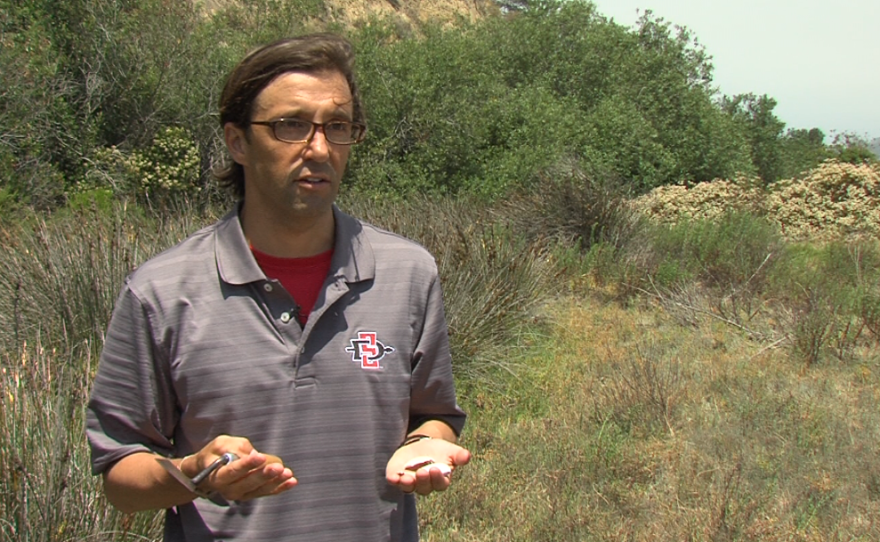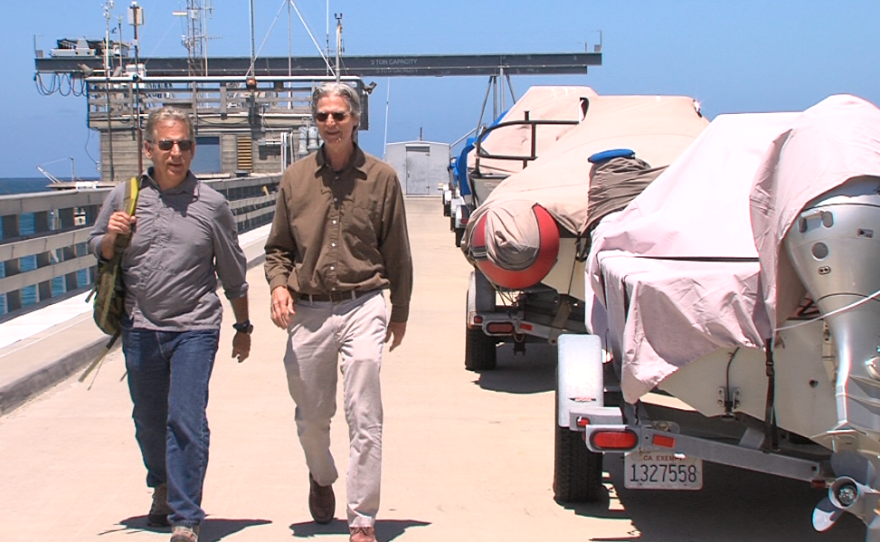Sea levels are rising due to climate change, and many living along the San Diego coastline could be affected in the not-too-distant future. To some scientists, this story sounds a bit familiar.
In the distant past, oceans were also rising, albeit for different reasons. To find out how ancient coastal people responded to changing sea levels, a number of San Diego researchers are undertaking the difficult work of exploring once-inhabited areas that are now underwater.
They are rallying around the field of marine archaeology, hoping to better understand how humanity has adapted to unstable shorelines.
Not far from a La Jolla beach, San Diego State University archaeologist Todd Braje hiked through brush, looking for signs of ancient life. He stopped at a patch of scrubland that would be pretty easy to miss. He was interested in the tiny seashells scattered across the dirt.
"It might not look like much at first glance, but this is actually a pretty high-density shell midden," Braje said.
Shell middens are basically ancient trash dumps. Thousands of years ago, coastal people ate shellfish and discarded the debris in piles that can still be seen in areas like this today.
"This is a pretty good indication that people were here for a decent amount of time. Enough to leave this much debris," Braje said.

This is what is left on land. But Braje said many important remnants of ancient coastal peoples could now be buried offshore. Sea levels around the world were once much lower. They rose as glaciers melted at the tail end of the last Ice Age, leaving areas where ancient coastal people likely lived underwater today.
"We can do this work along modern coastlines, but it probably only gets us so far," Braje said. "It only gets us to these sites where people were pulled inland. The best evidence might be underwater."
Braje and his colleagues are currently searching for that kind of evidence around the Channel Islands.
With funding from the U.S. Department of Interior, they surveyed offshore areas around the Southern California islands last summer, using sonar to pinpoint some promising leads. In a few months, they plan to go back and drop coring instruments to see what they can dig up.
Braje said in this region, this kind of work is new. He said it could possibly turn up evidence between 13,000 to 20,000 years old — evidence of what might have been the first people to ever populate this part of the world.
"We probably know more about the surface of the moon than we do about the underwater submerged landscape of the Pacific Ocean off of California," he said.
Scientists at UC San Diego and the Scripps Institution of Oceanography have also been planning their own search for underwater archaeological sites. Earlier this month, they officially launched the Scripps Center for Marine Archaeology.
From the Scripps pier, co-director John Hildebrand can look out and see beachgoers enjoying the sun and the waves. He said in the past, the scene would have been quite different.
"The people who were here 10,000 years ago — if they were living at the shoreline — that shoreline is now out there," Hildebrand said, gesturing out to sea. "The shoreline is not what we see today."
Scuba divers have found artifacts like stone bowls and grinding stones off the coast of La Jolla, suggesting there is more to find out there. Hildebrand is curious to know how people living here responded to changing sea levels. It is an important part of human history, he said, but it could also tell us something about our own present-day problems.
"We know that with rising CO2 levels and rising temperature, the next thing will be the ocean coming up," he said. "And if we look into the past and see those periods where there was rapid sea level rise, and see how people adapted to that, it is a help in thinking about where we're going in the future."
The new center at Scripps has plans to explore coastal areas around the world, in places like Puerto Rico, Belize and coastal California.
UC San Diego archaeologist Tom Levy is the center's other co-director.
He will be involved with an effort to explore a submerged Israeli port that would have been an important trade hub during the Old Testament reign of kings David and Solomon.
Levy has lots of experience digging in hot Middle Eastern deserts. But he was only recently trained to do field work while scuba diving.
"The only place where we find new data about biblical times and the biblical world is the archaeological record," Levy said. "And looking for those clues underwater in these areas that are just wide open for investigation is very exciting."
It could be awhile before these teams of scientists publish results from their expeditions. But they said it is great to see more and more researchers going underwater for a deeper perspective on humanity's connection with the coast.







